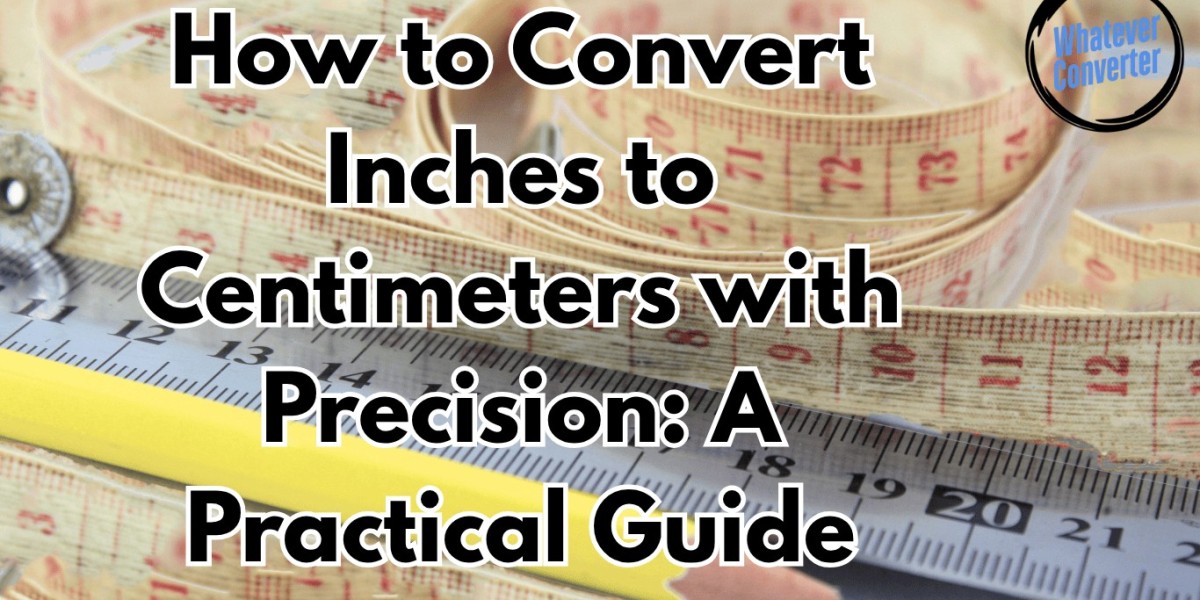Why Understanding Inches to Centimeters Matters
Whether you're designing a DIY project, buying furniture online, or working with international clients, accurate measurements are crucial. One of the most common conversions in daily life and professional work is inches to centimeters. Despite being simple on the surface, getting it wrong can lead to frustrating errors.
While the imperial system (inches) is dominant in the United States, most of the world relies on the metric system (centimeters). Because of this, understanding how to move between these two systems efficiently can save you time and prevent miscommunication, especially in technical fields like engineering, fashion design, architecture, and e-commerce.
With global markets growing increasingly interconnected, the need to convert inches to centimeters with precision is greater than ever. So let’s explore how to do that easily and accurately—without needing a math degree.
The Basic Math: How to Convert Inches to Centimeters
The conversion from inches to cm is based on a fixed mathematical formula:
1 inch = 2.54 centimeters.
This means that to convert inches to centimeters, you simply multiply the number of inches by 2.54.
For example:
5 inches × 2.54 = 12.7 cm
12 inches × 2.54 = 30.48 cm
20 inches × 2.54 = 50.8 cm
It’s really that straightforward.
If you often work with these conversions, it helps to memorize common equivalents. For instance, knowing that 12 inches equals 30.48 cm (roughly one foot) can speed up your workflow. On the other hand, if you're dealing with unusual measurements or fractions of inches, having a calculator—or a smart tool like WhateverConverter—can save you the hassle.
The key here is consistency and accuracy. Mistakes in measurement—even by a single centimeter—can throw off entire designs or lead to returns if products don’t fit as expected. This is especially true in sectors like interior design or online shopping for clothing.
When You Need to Use Inches vs. Centimeters
Although inches and centimeters are used for similar types of measurements (length, height, width), the choice between them often depends on your location or the industry standard.
Inches are most commonly used:
In the United States and Canada (especially for personal height, screen sizes, tools, etc.)
In aviation (runway lengths)
In construction projects in North America
Centimeters are used:
In most parts of Europe, Asia, and Latin America
In scientific and academic contexts
In medical measurements (height, waist circumference)
In digital and print design dimensions (especially with millimeters)
Knowing which unit to use helps you align with the expectations of your clients, customers, or team members. If you’re building a website for a global audience or selling products online, you should ideally offer both inches and centimeters to cater to everyone.
Fortunately, tools like WhateverConverter help you do this effortlessly. You simply enter your value in inches, and it returns the exact centimeter equivalent—instantly.
Tools That Make Conversion Easy
Let’s be honest: You don’t want to multiply everything by 2.54 in your head. That’s where free online tools come in handy. They simplify the process, prevent mistakes, and allow for faster decisions.
One of the most reliable options available today is WhateverConverter. It’s free, easy to use, and doesn’t bombard you with pop-ups or distractions. Simply type in the number of inches, hit convert, and you instantly get the correct centimeter value. Whether you're on a desktop or a phone, the interface is clean and responsive.
Other useful tools include:
Unit conversion apps (like Convert Units or Unit Converter Pro)
Google’s built-in conversion (type “12 inches to cm” directly)
Spreadsheet formulas (e.g., in Excel:
=A1*2.54if A1 has your inch value)
For developers, integrating conversion logic using APIs is also an option. But for most people, using a site like WhateverConverter offers the right mix of speed and accuracy.
Real-World Scenarios Where Precision Matters
Conversions might seem academic until you realize how many practical situations depend on them.
1. Online Shopping
When buying clothes or shoes from international stores, sizing charts often list measurements in inches. However, most international customers understand centimeters. If the sizing is off—even by a couple of centimeters—it could lead to product returns and poor customer reviews.
2. Interior Design and Home Renovation
Imagine ordering a sofa online that’s listed as 65 inches wide. Without converting that to 165.1 cm, you might think it fits—but you’d be wrong. That small oversight could cost you hundreds of dollars.
3. DIY Projects and Construction
Builders and hobbyists often mix tools and materials sourced from different countries. Precision here is critical. Using an inaccurate conversion could cause weak joints or misaligned installations.
4. Technical Documentation
Engineers, architects, and designers preparing blueprints or CAD models often need to ensure their work complies with local measurement standards. Misinterpreting an inch value as a centimeter—or vice versa—could lead to significant functional failures.
In all of these cases, converting inches to centimeters is not just about math. It’s about trust, quality, and outcomes. That’s why accurate tools like WhateverConverter are not just helpful—they’re essential.
Tips for Working Across Measurement Systems
Transitioning between inches and centimeters regularly? Here are some tips to keep your work accurate and streamlined.
Create a Quick Reference Chart
A printed or digital cheat sheet with common inch-to-cm conversions can save you time during busy work.Use Dual Measurement Tools
Rulers and measuring tapes that show both inches and centimeters side-by-side reduce errors.Label Units Clearly
When sharing designs, instructions, or specifications, always state the unit. For example, write “12 in” or “30.48 cm” instead of just “12” or “30”.Stick With One System When Possible
Switching between systems mid-project can lead to confusion. If you're working with international collaborators, agree on which system to use from the start.Automate with Digital Tools
Whenever possible, use calculators, spreadsheets, or WhateverConverter to avoid human error.
By integrating these strategies into your workflow, you reduce the chances of miscommunication and ensure your projects are built on reliable measurements.
Final Thoughts: Inches to cm Conversion is More Than Math
Understanding how to convert inches to cm is about more than memorizing a formula. It's a skill that improves your precision, saves you time, and enhances your professionalism—especially when dealing with international standards.
With the simple formula (1 inch = 2.54 cm) and tools like WhateverConverter at your fingertips, you don’t need to worry about making costly errors or guessing measurements. Whether you’re a student, a DIY enthusiast, or a working professional, converting units accurately is essential to your success.
So next time you come across a measurement in inches, don’t stress. Just open WhateverConverter, plug in the numbers, and move forward confidently.













